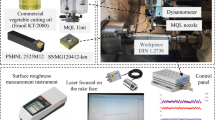Abstract
Optimizing the profit of an individual cutting tool is crucial to the computer numerically controlled (CNC) machining industry. In this paper, the mathematical modeling, the dynamic solution, and the decision criteria through calculus of variations are introduced to achieve the optimal material removal rate (MRR) control of a cutting tool under the fixed tool life. To realize the optimum MRR, a commercialized lathe system with a digital processor controller (DSP) and a man-machine interface is developed. Additionally, the implementation of dynamic MRR control for a real-world industrial case is experimentally performed on our proposed digital PC-based lathe system. It is found that the surface roughness (R a ) of all machined work-pieces not only stabilizes as the tool consumed, but also accomplishes the recognized standard for finish turning. In this study, the adaptability of the dynamic control of optimum MRR as well as the realization of the digital PC-based lathe system are absolutely guaranteed.
Similar content being viewed by others
References
Yeh LJ, Lan TS (2002) The optimal control of material removal rate with fixed tool life and speed limitation. J Mater Process Technol 121(2–3):238–242
Lan TS, Lan CH, Yeh LJ (2002) Dynamic machining project control model under order quantity and deadline constraints. J Oper Res Soc Jpn 45(1):83–92
Wang J, Luh PB (1996) Scheduling of a machining center. Math Comput Model 23:203–214
Fuh KH, Chen CT, Chang YF (1996) Design and implementation for maximum metal removal-rate control of a constant turning-force system. J Mater Process Technol 57:351–359
Rober SJ, Shin YC (1995) Modeling and control of CNC machines using a PC-based open architecture controller. Mechatronics 5(4):401–420
Kim TY, Kim J (1996) Adaptive cutting force control for a machining center by using direct cutting force measurement. Int J Mach Tools Manuf 36(8):925–937
Masory O (1984) Real-time estimation of cutting process parameters in turning. ASME J Eng Ind 106:218–221
Daneshmend LK, Pak HA (1986) Model reference adaptive control of feed force in turning. ASME J Dyn Syst Meas Control 108:215–222
Tomizuka M, Zhang S (1988) Modeling and conventional/adaptive PI control of a lathe cutting process. ASME J Dyn Syst Meas Control 110:350–354
Toutant R, Balakrishnan S, Onyshko S, Popplewell N (1999) Feedrate compensation for constant cutting force turning. IEEE Control Syst Mag 13(6):44–47
Koren Y (1983) Computer control of manufacturing system. McGraw-Hill, New York
Chiang A (1992) Dynamic optimization. McGraw-Hill, New York
Kamien M, Schwartz N (1991) Dynamic optimization. Elsevier, New York
Author information
Authors and Affiliations
Corresponding author
Rights and permissions
About this article
Cite this article
Lan, TS., Hsu, KS. The implementation of optimum MRR on digital PC-based lathe system. Int J Adv Manuf Technol 35, 248–254 (2007). https://doi.org/10.1007/s00170-006-0729-6
Received:
Accepted:
Published:
Issue Date:
DOI: https://doi.org/10.1007/s00170-006-0729-6




